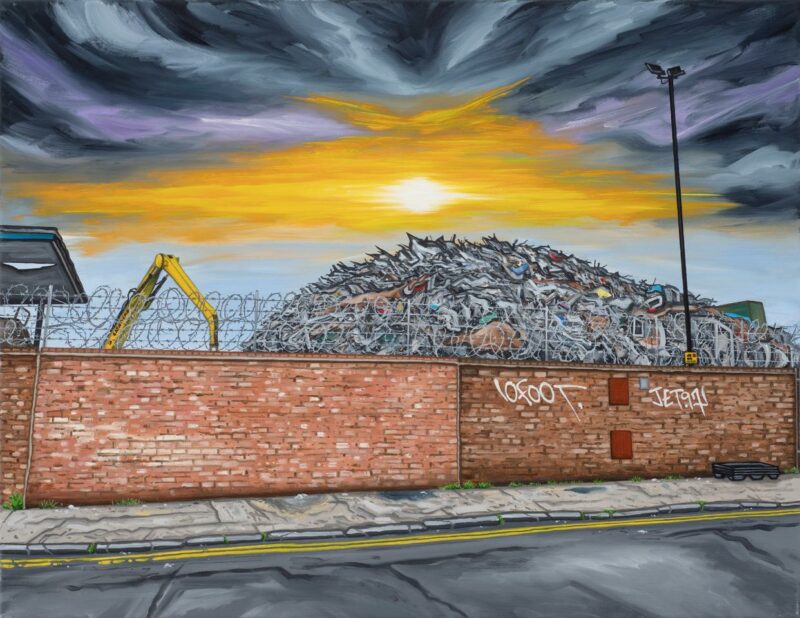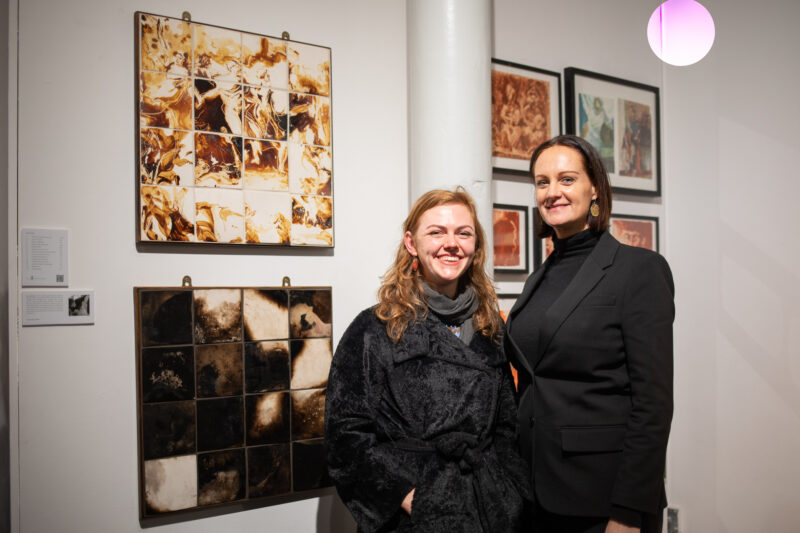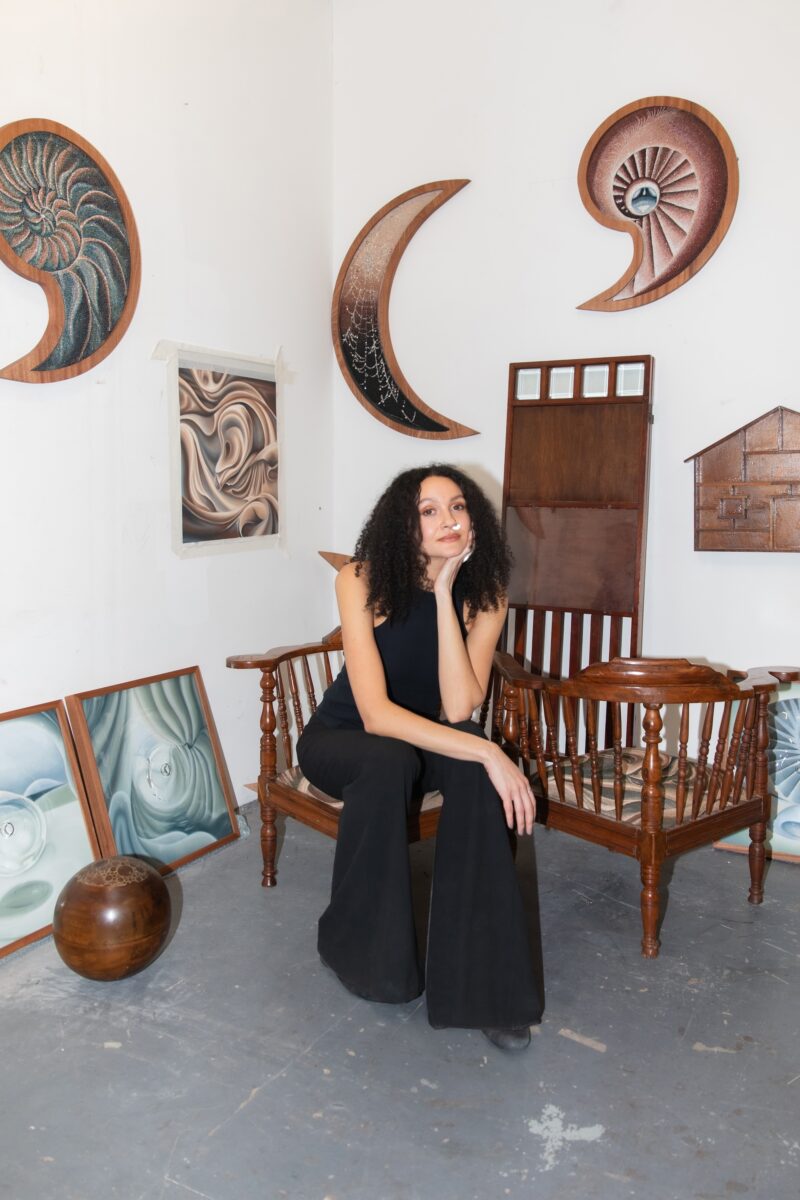
“All words are written in water”, is a statement that artist Charlotte Edey is emphasizing in discussing her newest series of work. Edey creates artwork that is grounded in spirituality and the cosmic, drawing on her interest in ritual, symbolism, and connection to the natural landscape, and she is able to retrieve these influences not only from direct connection but from the human-made rich transportative world of literature. Edey wants to communicate that water and language are linked and similar in that they each flow into us across epochs and generations.
Born in Manchester and currently living in London, Edey studied at the Chelsea College of Art and Design and the Royal Drawing School. Edey’s inspiration has come from literature, symmetry, and natural landscapes. She is part of a larger artistic family that transcends cultural boundaries that explore the relationship between spirit and politics, the use of textiles in her paintings, and the intuitive and improvisational nature of her artistic process.
Her artistic language is translated through what has, historically, been regarded as feminine craft and labor. By using tapestry, embroidery, beading, and organic shapes, she implements these devices to further the conversation of feminine bodies in an ever-changing landscape. Edey’s interest in flow and transportive ability of literature paired with her detailed imagery provides the viewers a new realm of exploration.
Edey has exhibited her artwork at Ginny in Frederick, Public Gallery, The Drawing Room, South London Gallery all London and The Design Museum, London. Her exhibition All Words Are Written In Water is at Anat Ebgi in Los Angeles from April 27th– June 15th 2024.
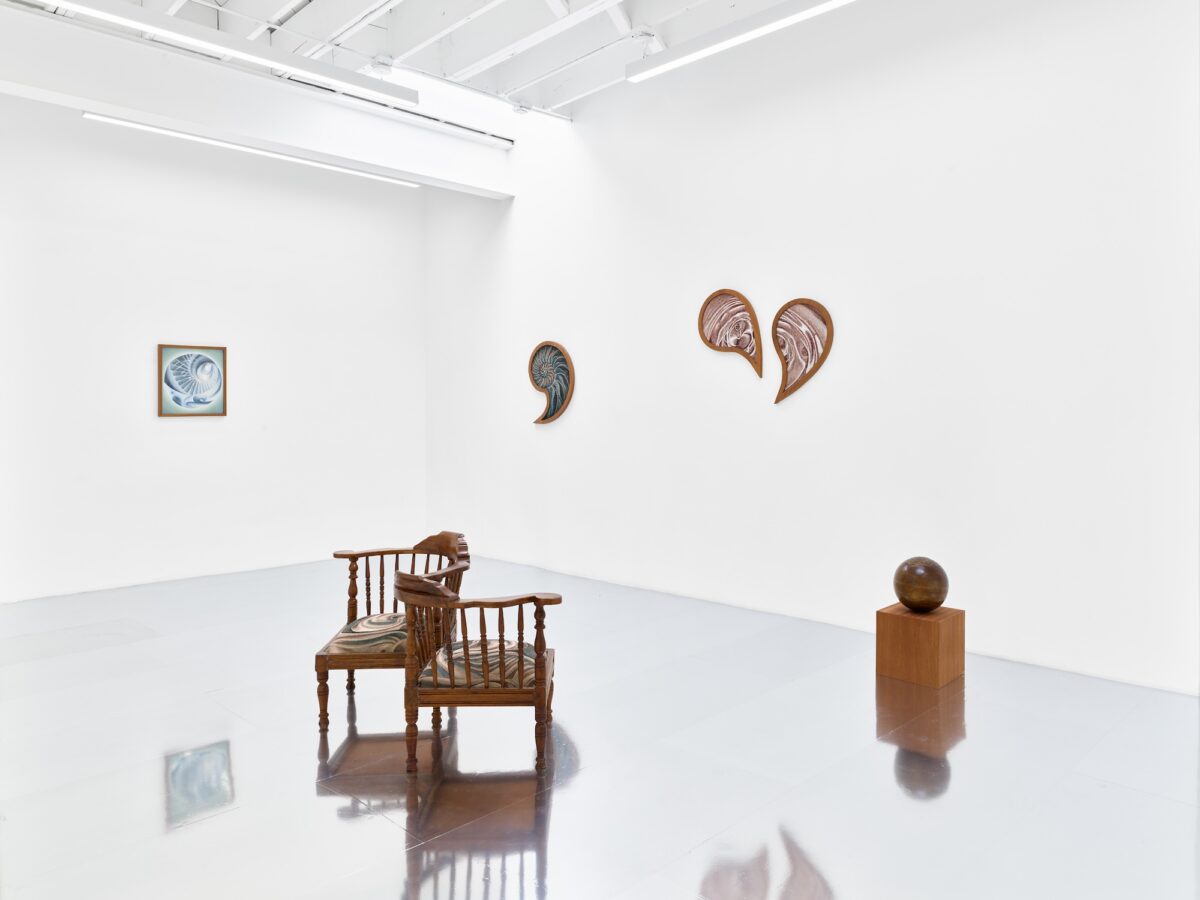
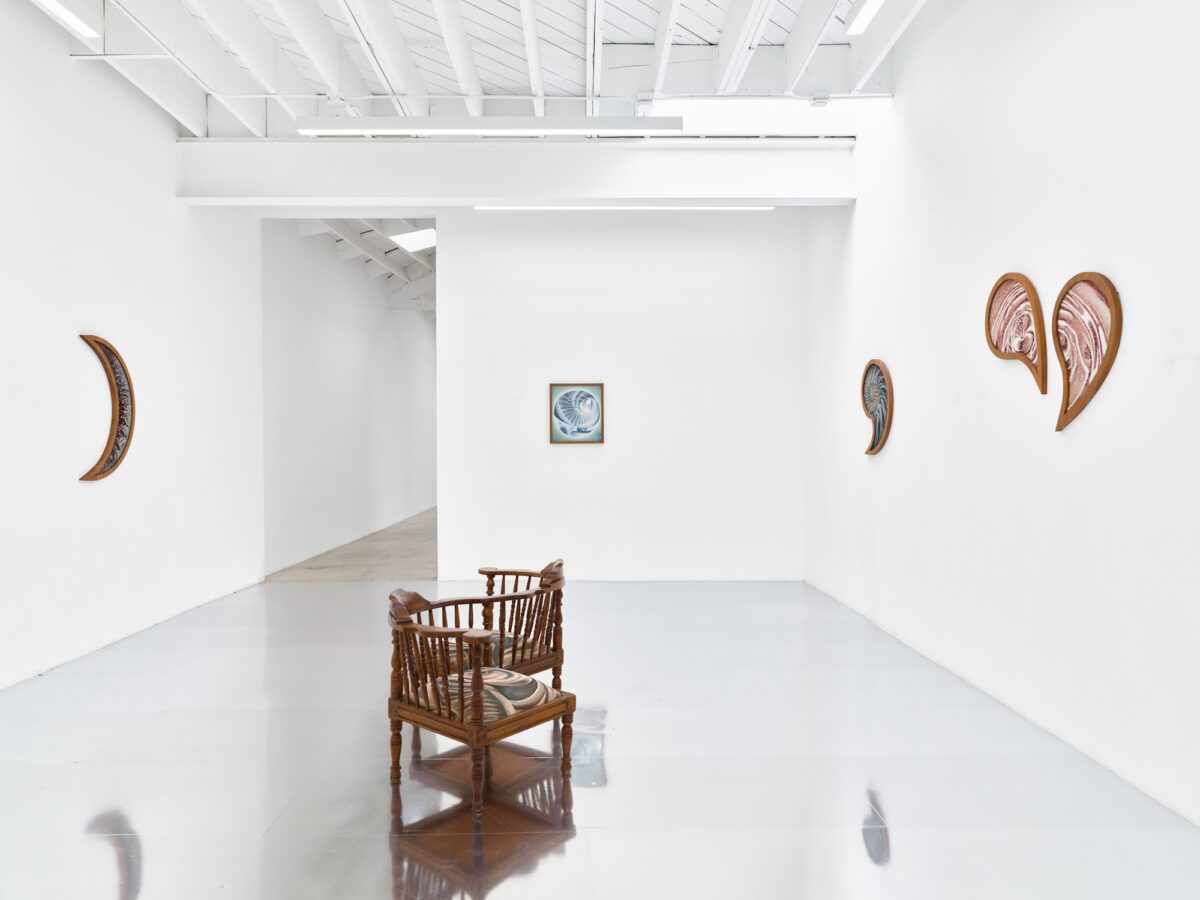
Phillip Edward Spradley: Congratulations on your inaugural solo exhibition in Los Angeles! Can you discuss the genesis of the work for this particular exhibition?
Charlotte Edey: The title is taken from the Maggie Nelson text Bluets, 2009: “I am writing all this down in blue ink, so as to remember that all words, not just some, are written in water.” – Maggie Nelson. It paraphrases the epitaph that Keats asked his friends to have carved into his gravestone—only these words, not his name— “Here lies One Whose Name was writ in Water.” I am drawn both to the material application of the idea: that all words in physical form are formed by ink (water) whether analog or digital and the ephemerality of the phrase. Wilde references the grave in a later sonnet: “Thy name was writ in water—it shall stand, And tears like mine will keep thy memory green.”
This body of work emphasises an ongoing interest in post-structuralist notions of identity that suggest that at all stages of life, self-hood is plural, fluid and fragmented. I frequently use texts as research and I was considering the linguistic genesis of these thoughts that later become objects and the parallels of this fluidity between language and embodiment.

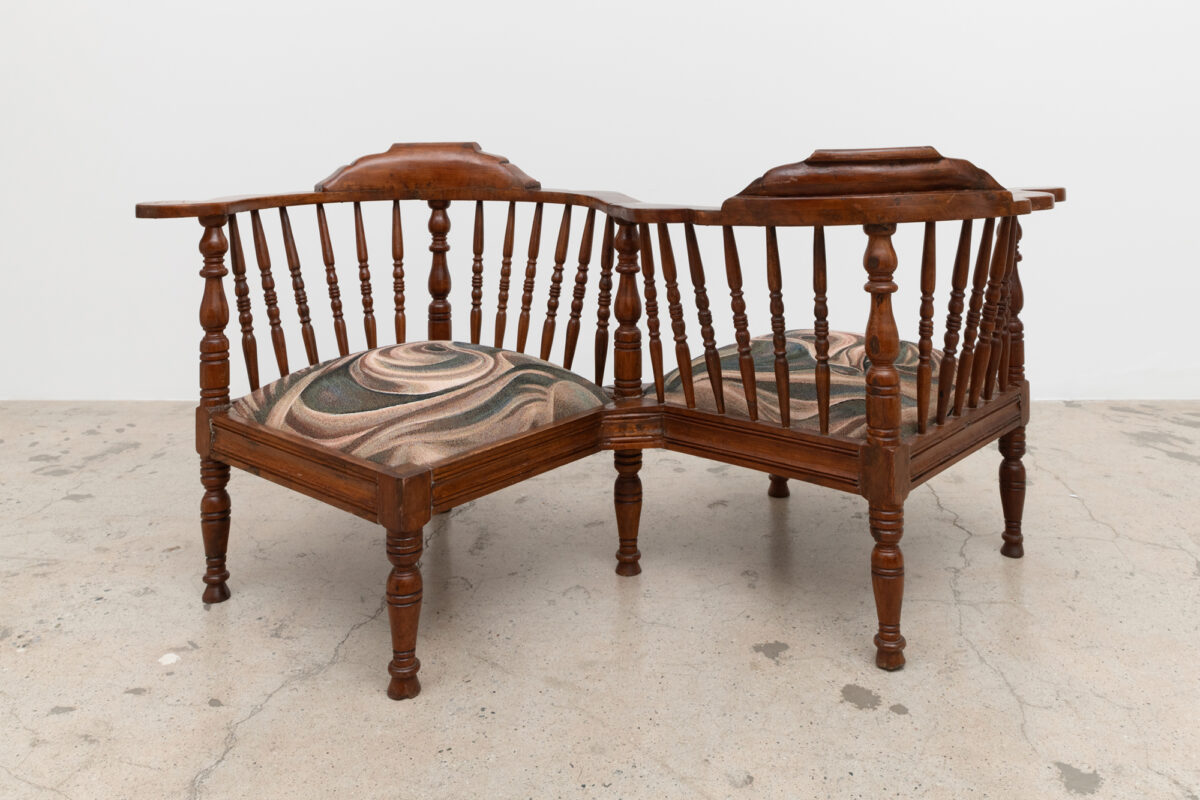
You’ve expressed that when reading you noticed the breaks in words, the quotation marks, the commas, and with that you were able to notice the liquidity in words and the physicality of this form. Was there a particular type of writing or author you were reading that allowed you to see the connections in these symbols? Was it a long engagement of understanding or an eureka! moment?
When researching this show, I had been circling ideas around cadence: the breaks and rhythms as an act of arrangement, considering the flow of a sentence as a kind of melody or pattern. Jackie Wang describes the sentence as a ‘technology of consciousness, with its serpentine twists and turns, perverse digressions and rhythmic pulsations’. I was reflecting on these symbols that pause an unbroken stream; considering punctuation marks as the structures that transform letters to mental images. I was drawn to the semiotics of punctuation as a study of markings – how they draw from musical notes to not only indicate tone and rest but as signs that signal meaning. I’d been reading a lot of Claire-Louise Bennet and Maggie Nelson, heavily cited texts and thus laden with symbols.
Within this show, the dots and dashes of commas become nautilus shells, quotation marks flow like droplets of water and tears, brackets form waning crescent moons, full stops interchange with pearls and bubbles. These marks are anchored to a liquidity of form and through a lens informed by posthuman hydrofeminist theory and feminist new materialism, form symbolic structures to consider what it means to inhabit a watery body.


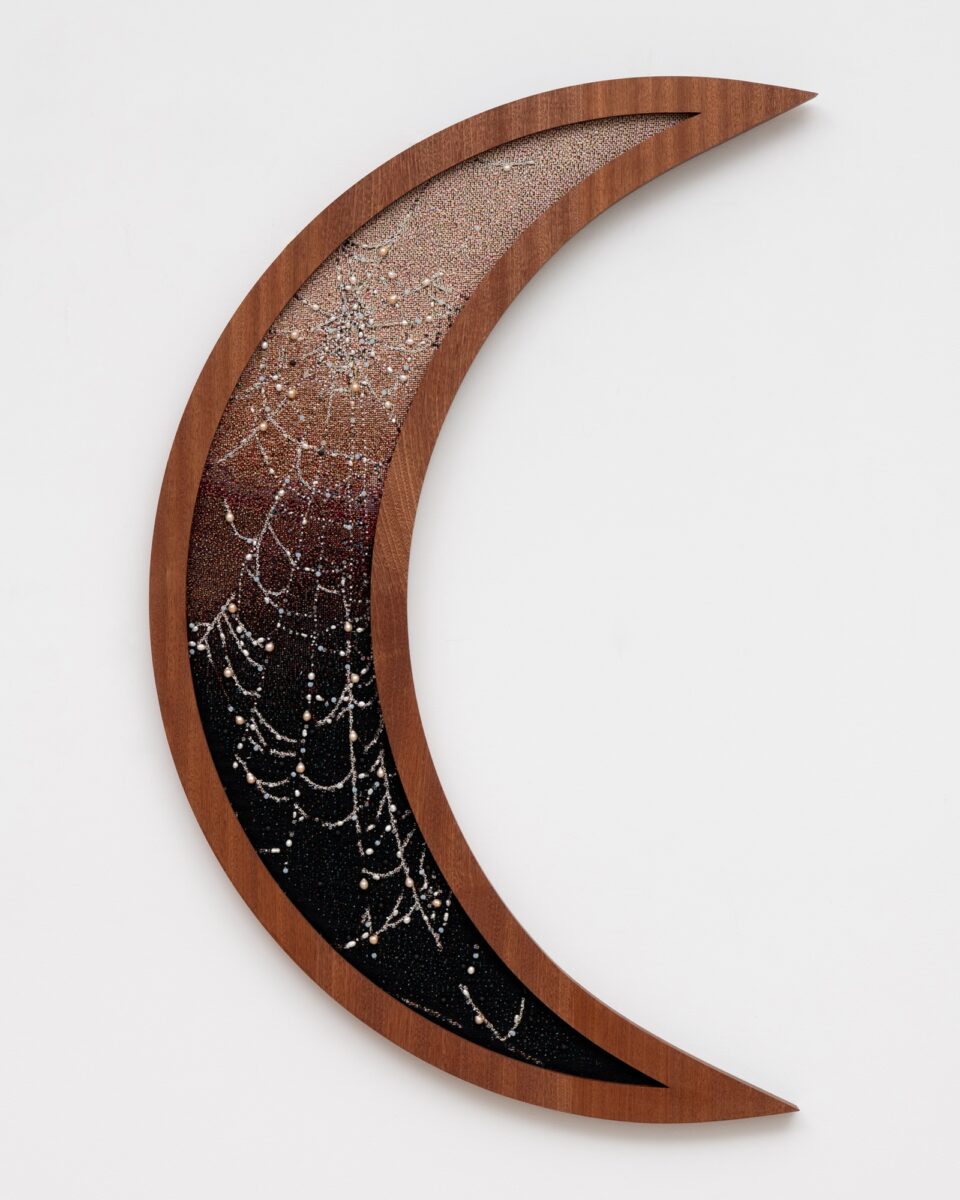
Could you elaborate on your interests in etymology and how that relates to the vernacular and humanistic associations around bodies of water and landforms? Are there other fascinations that you embedded within these artworks?
Regarding etymology, I’m interested in how meaning shifts over time, visually and linguistically. I undertook a period of research on the Jurassic Coast on the southern English coast on the traces left by fossilised ammonites to inform some of the imagery in this show. The area’s geological record of the Mesozoic Era is world-renowned, charting the remnants of an ancient, disappeared sea of the pre-human era. The fossils of Lyme Regis were highlighted through the work of Mary Anning in the early 19th century (the subject of the tongue twister “She sells sea shells…”)!
At the time I was looking at pretty much everything through the lens of symbols and found such an interesting language in the shells, stones and fossils across the beaches. Remarkably preserved spirals, fragmented imprints reminiscent of eyelashes, stones crisscrossed with fine lines like runes or inscriptions, some sort of calligraphy lost to time. In ‘Step Towards a Small Theory of the Visible’, John Berger states ‘In this realm of the visible, all epochs coexist and are fraternal, whether separated by centuries or millenia’; an echo of Astrida Neimanis’ ideas on ‘aqueously extending through both time and space’ that connects us to ‘all the strange bodies of water that flow into us across epochs and generations.’ Truthfully, the residency felt like a period of time-travelling and rooted the imagery in the show with the visible of the past.
What other steps did you take to inform these connections?
There are these sort of metaphysical geometries that structure the show. Nautilus shell spirals mirror ascending staircases, dew-coated webs resemble tear-stained eyelashes. The show itself is mirrored, with each individual work one part of a larger whole – a wider network of association and analogies.
You mentioned that language references water in ways to elaborate emotions and thoughts. You even provided examples which creatives have demonstrated in their progress that are highly illustrative of water, “the flow of creativity”, “stream of consciousness” to “make waves”. Do you find yourself constantly referencing the natural world? Is it a system integral towards your creative endeavors?
We discuss streams of consciousness, words that wash over us, our immersion in ideas, torrents of abuse and whether prose successfully flows. These watery metaphors represent a pace at which words are measured, the ebb and flow of language; of how water can describe our way of speaking, of thinking, of feeling.
I sort of think the idea of separation from the natural world is something of an illusion. In Bodies of Water Neimanis discusses our bodies ‘wet constitution in relation to the planetary role of water – a school of thought that understands our bodies as fundamentally a part of the natural world, not separate from it or bearing any privileged relation to it.’ I suppose that being concerned with interiority necessitates an acknowledgement of the exterior in order to discuss that threshold or blur. Considering human embodiment as fluid and inherently tied to planetary bodies: oceanic tides feel bodily in their response to the rhythms of the moon and sun that mirror our own. Symbolically, the saltwater quality of tears and sweat or the veinlike flow of rivers are reminders of the ever-changing fluidity of our own forms. As Virginia Woolf put so simply: ‘there are tides in the body’.


You have an interest in cultural histories, antiques, fossils and past lives. Looking at found objects and the ancients provides a mysterious allure that allows people to reflect on their innate curiosity about the human experience throughout time and our desire to understand our place in the broader narrative of history. How do you grasp and channel that experience of discovery and understanding?
I worked with author Vanessa Onwuemezi on the text – an original piece of fiction titled The Third Fold – for this show. Over multiple studio visits and shared references, we kept returning to the Toni Morrison quote: “Everything is now. It is all now.”
This relationship to time is grounded in the materiality of the show. The centre of the show is a conversation chair which were popularised during the Gilded and Victorian ages. Conceived in 19th century France, the serpentine shape echoes how water sculpts landscapes, while its history is entwined with communication and the body, allowing for a verbal intimacy with a physical distance. The soft pastel drawings are presented under found 19th century bullseye glass, distorting the drawings beneath. A familiar feature in British Victorian architecture, this early glass-making method creates a droplet effect by spinning molten glass with a pontil (the navel), which ripples out like water in motion.
I am interested in how using found objects creates a dialogue with the pre-existing narratives of these objects and imbues them with a sense of context or location. I feel that our set of personal archetypes and histories – inherited, translated, mythologised across generations – foreground our lived experiences and become the lens through which we see the world and as such, the past is often deeply present.
The colors you utilize are similar to the imaginary, they are surreal and invoke an otherworldly place, these are not colors found locally in London. Where do you locate this luminosity?
I’m interested in world-building; much of my landscapes are imagined and I enjoy a sort of speculative fiction approach to light and colour. I’m drawn to Goethe’s holistic view of colour, where the borders between outside and inside, as well as between object and subject, remain porous: ‘If the eye itself were not sunny, how could we perceive light?’
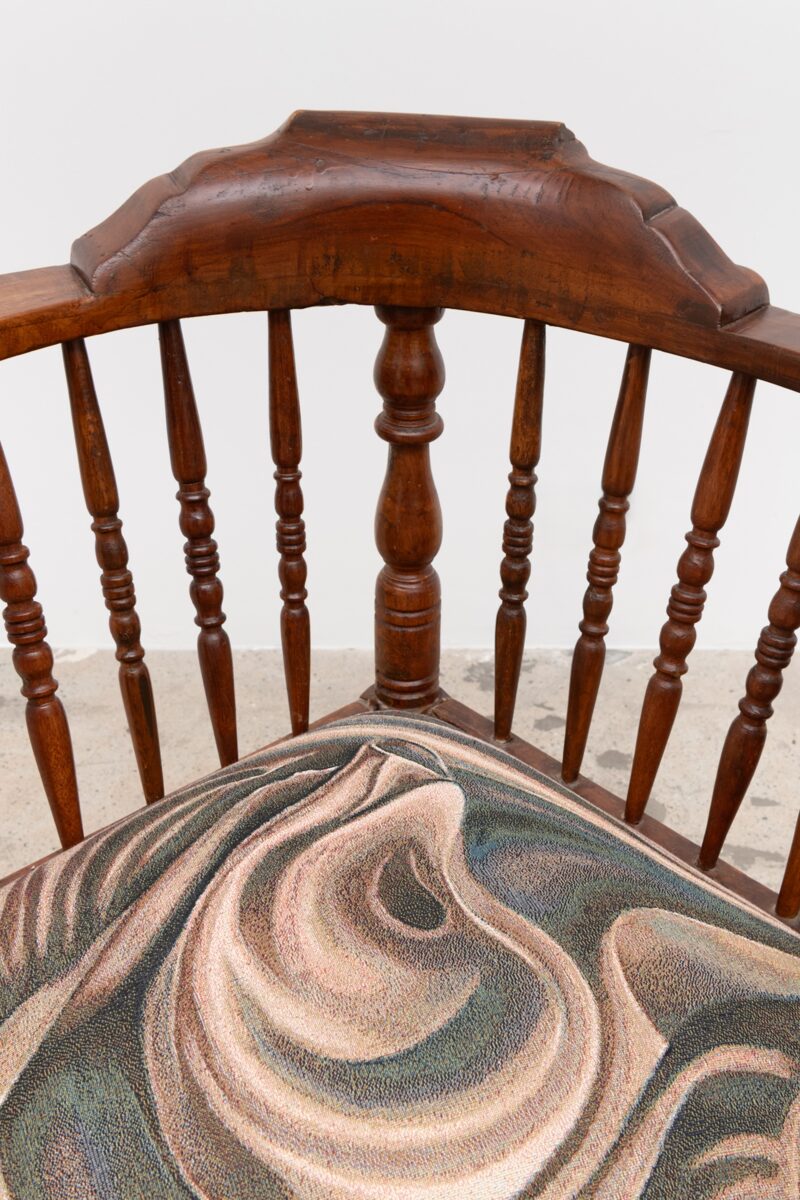
At its base you work consists of pastels, beads, minerals, wood, wool, and it is tethered and fixed to a space, yet your artwork does not seem stable, it’s all shifting, and changing, it provides a moment, a window, a different landscape and ultimately a different way of perception. How do you believe your material choices help with this fluidity and consistent change?
There is something interesting in how the beads transform the surface of the works. In some ways it is like drawing with light: they carry their own luminosity, moving with and responding to changing light and feel unfixed and slippery. The bullseye glass also has this quality. Alongside the glass seed beads and freshwater pearls for the woven works, I was working with organic materials including crystal, moonstone, opalite, obsidian, onyx, lava, and topaz for this show which added a different push and pull to the surface. I consider my works slippery or fragmentary; the frames are the wooden vessels that contain them, as though they would spill out otherwise.
To learn more about Charlotte Edey, follow her on @edey_ visit her website at charlotteedey.com and see her exhibition All Words Are Written In Water at Anat Ebgi Wilshire



